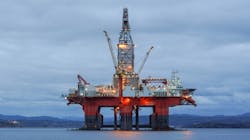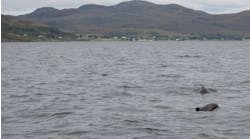A tale of two North Seas: Norway incentivizes drilling while UK levy could lead to rig loss
Editor's note: This cover story first appeared in the May-June 2023 issue of Offshore magazine. Click here to view the full issue.
By Bruce Beaubouef, Managing Editor
To paraphrase from Dickens’ classic work, the North Sea has become a tale of two seas: the UK North Sea and the Norwegian North Sea. The difference, which is already being manifested in drilling activity and field development plans, comes down largely to extremely contrasting fiscal regimes and regulatory policies.
In the UK North Sea, drilling activity has been hampered by the Energy Profits Levy (EPL) enacted last spring, a fee that was subsequently increased by an additional 10% late last year, bringing the headline tax rate for UK oil and gas producers to 75%. The increased fees have led some UK North Sea operators to slow their drilling campaigns, and put the brakes on field development projects that could have seen FID this year.
Already this year, the UK North Sea, which has been fairly active in recent years, has seen a decline in floating drilling rig activity. With the global rig market tightening, and the economics of the UK North Sea less appealing, some drilling contractors are now anticipating moving their rigs out of the North Sea and into more rewarding environments. Harsh environment semisubs could be particularly impacted, as their owners and managers look to deploy these high-demand rigs for drilling campaigns off South Africa or offshore Australia.
For example, Odfjell Drilling recently announced that its semisubmersible Deepsea Mira will leave the North Sea for a 300-day contract with TotalEnergies in Namibia in 2Q 2023. Other rigs are departing the UK North Sea too. The only drillship in the region, Deep Value Driller, has been bareboat chartered by Saipem and will move to Cote D’Ivoire to drill for Eni this year. Apache recently announced an early contract termination for Diamond Offshore’s Ocean Patriot. The semisubmersible rig should now become available in July, more than 400 days earlier than planned. Apache said the cancellation followed the changes to the EPL.
According to Westwood Global Energy Group’s Teresa Wilkie, a letter of intent awarded to a sixth-generation semi by a UK operator has been cancelled after the company overhauled its UK drilling plans. The rig could have been contracted until 2030 if all options had been taken up but will now be available on completion of its current UK drilling campaign in mid-2024.
The International Association of Drilling Contractors’ North Sea Chapter recently sent a letter to all 650 UK MPs and 129 MSPs warning that further harsh-environment rigs could be “lost for good” to the UK due to the windfall tax changes.
A Westwood Insight published last November found that despite improving North Sea rig conditions, assignments elsewhere commanded longer durations and higher day rates.
RigLogix counts four cold-stacked rigs at present in the North Sea at large, comprising three semis and one jackup, and nine warm-stacked rigs (five semis and four jackups). Only three of the latter have work lined up, in two cases outside of the region. And 15 further rigs could come off contract before the end of this year if follow-on work is not secured or options not declared. A high-spec, harsh-environment semi currently in the North Sea could relocate later this year to drill in the eastern Mediterranean.
As for jackups, Valaris reportedly plans to preservation-stack the Valaris Viking as a cost-reducing measure as it does not foresee sufficient work in the region to keep all three of its harsh-environment rigs operating due to weaker North Sea demand related to the fiscal changes.
And once rigs exit the region, they may not return, said Wilkie, due to a combination of high mobilization costs and more attractive contract terms and day rates in the Golden Triangle region, the Middle East, and Australasia. This would lead to a smaller pool of rigs within the North Sea region, with less choice and higher day rates for operators planning fresh campaigns in the years ahead.
In addition, several field development projects planned for the UK North Sea could be jeopardized by the EPL. Wilkie said that the UK North Sea outlook could worsen considerably if offshore operators decide their projects are no longer feasible in the current financial climate. TotalEnergies, Equinor, Shell and EnQuest have announced plans to reduce their UK offshore expenditure this year, and FID for planned greenfield projects, such as Ithaca Energy’s West of Shetland Cambo oil development, may also be at risk due to the EPL.
In March, Equinor awarded contracts for the use of the Transocean Encourage, mainly in the Norwegian Sea; and Transocean Enabler, for the Johan Castberg field, in the Barents Sea. The two companies also signed a strategic collaboration agreement. The rigs have been on eight-year contracts with Equinor – one that expired last December and one that will expire in April 2024, respectively. This will be the first contract extensions for these rigs since they were built, as so-called Cat D rigs, specialized for Norwegian conditions. The drilling program in the Norwegian Sea consists of nine wells to be drilled on the Tyrihans, Verdande, Andvare and Vigdis fields located in the Tampen area of the North Sea.
Verdande and Andvare will be tied in to the Norne field. The drilling program also includes exploration wells and may be further extended, adding six wells. The estimated total value of the nine wells is about $191 million. The Transocean Encourage and the Transocean Enabler are sixth-generation fully winterized, harsh-environment semisubmersible rigs with automated drilling control specially designed for operations on the Norwegian Continental Shelf.
Development spending offshore Norway, buoyed by an ostensibly temporary tax regime, is expected to increase significantly following the submission of plans for multiple projects late last year. According to Rystad Energy, the overall capex of greenfield investments proposed in 2022 will be $42.7 billion. The Norwegian government implemented its temporary tax regime during the 2020 market downturn to secure future development spending. The measures incentivized operators by boosting the uplift rate on all ongoing investments in 2020 and 2021, and on new projects sanctioned before 2023 up until first oil flows. Despite a reduction in the uplift rate last year from 2020’s 24% to 12.4%, the temporary regime still lifts the net present value and lowers the breakeven prices of development projects.
Operators on the Norwegian Continental Shelf strove to submit their plans of development and operation before the new standard regime took effect at the start of this year. Of the 35 projects sanctioned within the temporary regime, 24 were sanctioned in 2022, a record for Norway in a single calendar year, with the total value of these projects likely to approach $29 billion. Greenfield spending from the 35 projects should climb steadily over the next three years, to $9.1 billion in 2024, $7.4 billion in 2025 and to $6.3 billion in 2026. The combined resources are estimated at 2.472 Bboe.
Some of the key upcoming field development projects in the Norwegian North Sea include Aker BP’s North Sea Yggdrasil Hub (startup in 2027), Shell’s Phase 3 of Ormen Lange (startup in 2025) and Equinor’s Irpa (startup in 2026). These projects are expected to provide a significant boost to Norway’s gas supply. And NCS liquids production should also be steady going forward, helped by the Yggdrasil Hub, Equinor’s Breidablikk (start-up in 2025), and Vår Energi’s Balder Future (start-up in 2024).
It should be noted that the main suppliers of gas will continue to be major fields sanctioned during the standard tax regime, such as Johan Sverdrup in the North Sea.
Rystad estimates the additional supply of gas in 2028 at about 24.9 Bcm, close to 6.225% of demand in the EU and the UK combined, with Norway accounting for almost one-third of European gas supplies in five years.
And those projects sanctioned under Norway’s temporary tax regime should help sustain high gas production on the NCS through 2030. Rystad Energy estimates that production from the tax window projects should peak at 921,000 boe/d in 2028. Thereafter, based on current plans, production could slip to 818,000 boe/d in 2029, 659,000 boe/d in 2030, then evening out at 254,000 boe/d in 2035. The firm’s upstream analyst Mathias Schioldborg said: “The outcome of this tax break is threefold: increased investment on the NCS, increased tax receipts when production starts and increased supply to Europe at a critical time. Norway will need to consider if this regime is a one-off to attract investment or if lessons can be learned for the future.”






